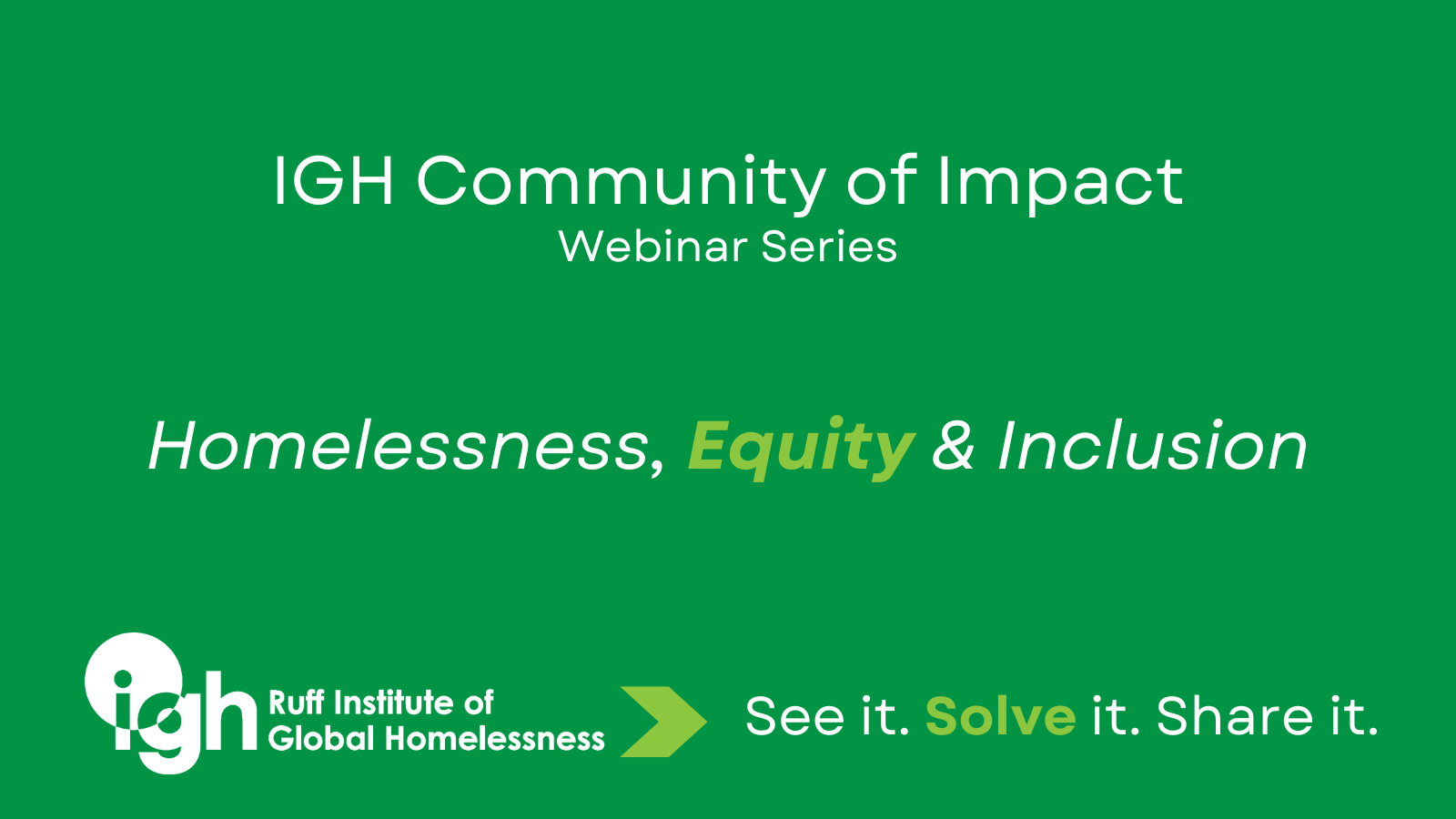Although structural and systemic racism may look different throughout the world, we see an undeniable global throughline between racism and homelessness, with homelessness disproportionately affecting groups who have been historically marginalized. The Institute of Global Homelessness (IGH), Funders Together to End Homelessness, the National Coalition for the Homeless (NCH), and the Canadian Lived Experience Leadership Network (CLELN) have a shared commitment to actively working to counter inequities, including racism, in the work to prevent and end homelessness.
For our first Community of Impact webinar this year, we were joined by Donald Whitehead — Executive Director at National Coalition for the Homeless — a national network of people with lived experienced homelessness; activists; advocates; community-based and faith-based service providers; and others committed to preventing and ending homelessness while ensuring the immediate needs of those experiencing homelessness are met and their civil rights are respected and protected. The discussion was moderated by Stephanie Chan — Chief Strategy Officer at Funders Together to End Homelessness. Funders Together to End Homelessness provides critical resources and learning and networking opportunities to our members to increase their knowledge, capacity, and effectiveness in both the individual and collective work around housing justice as a way to end homelessness and housing instability.
Donald shared details about NCH’s Lived Experience Training Academy (LETA) — a development course designed to equip people with lived experience of homelessness to occupy leadership roles in advocacy work. LETA is led and designed by Donald and his colleagues Dr. Rajni Shankar-Brown, David Peery, Jeff Olivet, and Michelle Bush and informed by focus groups conducted with people with lived experience. LETA’s core curriculum includes the history of homelessness, financial literacy, organizing and advocacy incorporates themes such as accounting for trauma, self-care, and transformative leadership practices.
During a robust question and answer (Q&A) session, participants inquired about practical approaches to equitable partnership with people with lived experience, how to respond to resistance to DEI efforts, avoiding tokenism and ensuring that people with lived experience have decision-making power.
Donald highlighted that at NCH, centering lived expertise has become common practice and is embedded throughout NCH’s policies and practices. He said, “when we start a project, the first thing that we do is figure out how it affects people experiencing homelessness”. He shared insights about how homelessness, housing and public health agencies such as the United States Department of Housing and Urban Development (HUD), the United States Department of Health and Human Services (HHS) and the Center for Disease Control (CDC) have taken a collective impact approach by coordinating their effort to learn what works and what doesn’t work. He also highlighted that agencies like NCH have proven that the centering of lived expertise and racial equity can both be prioritized in social change work. Donald suggested that practitioners in social change work be informed about traumas associated with lived experience and be intentional about preventing further harm when people with lived experience are contributing to the work. LETA’s inclusion of trauma-informed care as part of the curriculum helps to prevent re-traumatization of people with lived experience entering advocacy work. Learn more about racial equity here.
Stephanie suggested that tokenism can be avoided when practitioners, stakeholders, researchers and advocates work alongside people with lived experience — ensuring that they have roles at all levels of the work to prevent and end homelessness, and other intersecting issues. Learn more about rights-based participation here and about equity-based decision-making here. In closing, she left everyone with this question for reflection:
“If you do not have lived experience and have occupied or currently occupy a position of leadership and/or decision-making, what kinds of learning or training opportunities can you use to become more equipped to relinquish power so that people with lived experience can occupy space and be a part of decision-making.” (paraphr.)
We recognize that learning how to carry out the work to prevent and end homelessness equitably is never done. We are committed to continuous knowledge exchange with our global community about the intersection between homelessness and diversity, equity, and inclusion and transparency about our progress and implementation.
Links to Resources
- Webinar recording: https://youtu.be/qC45-Yu3-Gw?si=4C3TnRS479LVuOzN
- National Coalition for the Homeless
- The Lived Experience Training Academy https://nationalhomeless.org/leta/
- Engaging with People who have been Homeless https://nationalhomeless.org/wp-content/uploads/engaging-lived-experience.pdf
- Violence and Hate Against Unhoused Americans: 2020-2022 https://nationalhomeless.org/wp-content/uploads/2024-Hate-Crimes-Report_for-web.pdf
- Funders Together to End Homelessness
- Embracing Trust and Loving Accountability https://www.funderstogether.org/2023_funders_institute_embracing_trust_and_loving_accountability
- 2024 Funders Forum: Advancing Housing Justice through Reparations and Transformation https://www.funderstogether.org/2024_funders_forum_recap
- Nothing About Us Without Us: Takeaways from the 2018 True Colors Fund Impact Summit https://www.funderstogether.org/nothing_about_us_without_us_takeaways_from_the_2018_true_colors_fund_summit
- Canadian Lived Experience Leadership Network
- Nothing about us without us: Seven principles for leadership & inclusion of people with lived experience of homelessness https://www.homelesshub.ca/sites/default/files/LEAC-7principles-final.pdf
- Checklist for planning inclusive and accessible events https://www.homelesshub.ca/sites/default/files/attachments/LEAC-7principles-checklist-final.pdf
- Lived Experience Declaration of Rights https://bfzcanada.ca/wp-content/uploads/CLELN-Lived-Experience-Declaration-of-Rights-Zine-2022.pdf
- Equity-Based Decision-Making Framework — National Innovation Framework https://drive.google.com/file/d/1dxCU9vg-sSTBlh0PCxc_Rj__mob6HO6W/view?usp=sharing
- There is No Such Thing as the Voiceless — Malaka Shwaikh https://blogs.lse.ac.uk/mec/2021/05/12/there-is-no-such-thing-as-the-voiceless/





